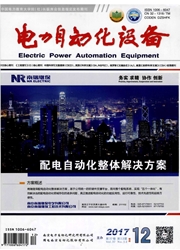

 中文摘要:
中文摘要:
考虑在配电网中加入同步相量测量单元(PMU)进行潮流计算,理论上正确可行并能提高配电网潮流计算的收敛速度。但在实际应用中,PMU存在一定的测量误差,使用传统前推回代潮流算法和对负荷静态电压特性变化敏感性弱的前推回代算法分别对IEEE 33节点配电系统进行测试,结果表明:不考虑PMU测量误差时,使用传统前推回代潮流算法能够保证潮流计算结果的精度并能提高计算收敛速度;考虑PMU测量误差时,使用对负荷静态电压特性变化敏感性弱的前推回代算法抗误差性更强;2种算法都表明将PMU安装于普通节点时的算法计算精度比PMU安装在DG节点时高。
 英文摘要:
英文摘要:
Though the power-flow calculation with the consideration of PMUs(Phasor Measurement Units) in distribution network is theoretically accurate,reliable and fast,PMU effects the practical applications due to its measuring error. IEEE 33-bus distribution system is adopted to test the traditional back/forward sweep algorithm and the back/forward sweep algorithm with weak sensitivity to the variation of load static voltage characteristics respectively and results show that,when the measuring error of PMU is not considered,the traditional back/forward sweep algorithm can ensure the accuracy of power-flow calculation and improve the convergence rate;when the measuring error of PMU is considered,the back/forward sweep algorithm with weak sensitivity to the variation of load static voltage characteristics has better error-resistant performance;the calculation accuracy of both algorithms when PMU is equipped at normal node is higher than that when it is equipped at DG node.
 同期刊论文项目
同期刊论文项目
 同项目期刊论文
同项目期刊论文
 期刊信息
期刊信息
